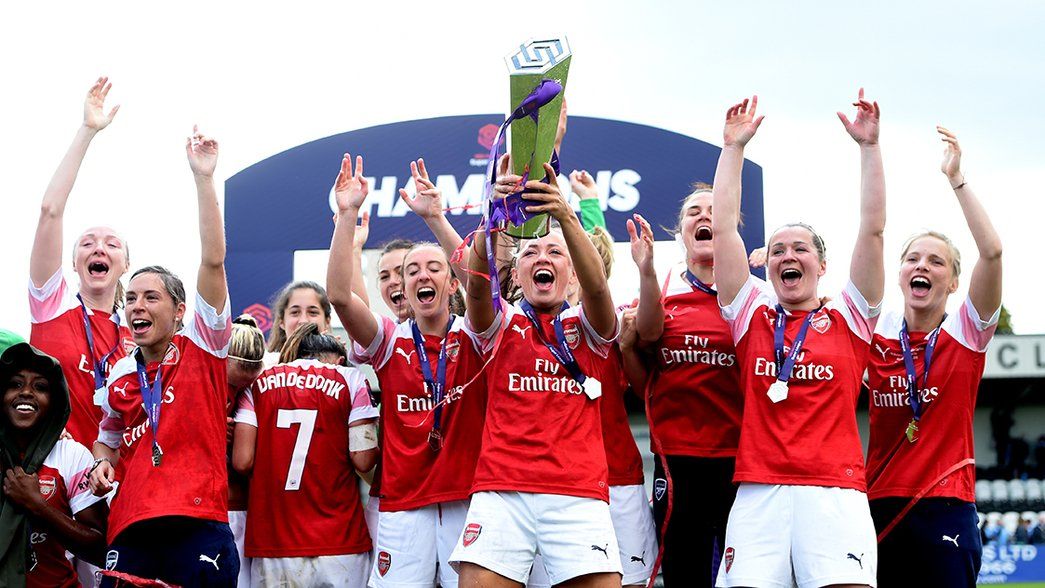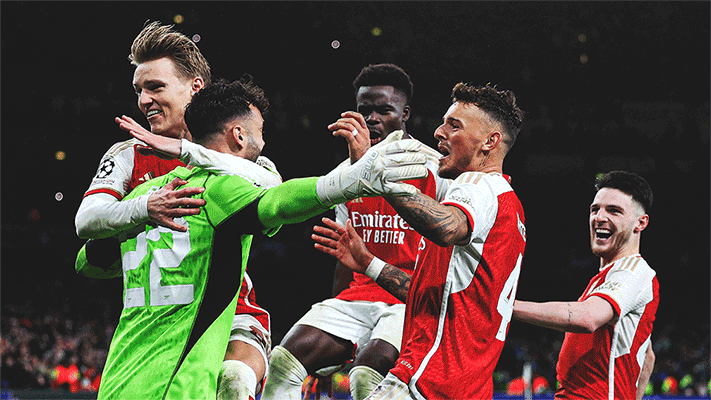Our 2018/19 FA Women’s Super League season will go down in the history books.
Not only did we bring the title back to north London for the first time since 2012, we also secured it in typical Arsenal fashion, breaking a number of WSL records along the way.
But it’s important to note that while a number of our stars have naturally taken the headlines, everyone in the camp played their part - and for many individuals, it was the best season of their career to date.
Read on for an in-depth statistical analysis of our incredible season…
OUR WELL-DRILLED DEFENCE

An organised and resilient defence is imperative to any title-winning side - and thanks to Joe Montemurro’s tactical nous, we’ve been able to build just that.
Our head coach has received plenty of praise for our free-flowing attacking football, but in truth, our defensive record has been equally as impressive.
Not only did we concede the fewest goals in the division (13), we’re also the only side that failed to drop a single point from winning positions last season.
This is in part down to the reliability of Pauline Peyraud-Magnin and Sari van Veenendaal, who kept seven and five clean sheets respectively, in addition to our back line offering no way through. No other side faced fewer shots at goal (141).
To put these numbers into perspective, Yeovil Town’s Megan Walsh was forced into making 144 saves last season, which makes for quite the comparison to our duo’s combined 34.
So what about the outfield players that have helped to build that wall?
Leah Williamson and Louise Quinn were our most popular defensive pairing last season - and it’s no wonder when you see just how much they contribute to the side.
Williamson finished the season as our most active player on the ball with 1,501 touches to her name, as well as completing the most successful passes in the opposition’s half (591). She also made more interceptions than any other player in our squad (30).
Meanwhile, Quinn, who arrived at the club with a reputation as a tough-tackler, has transformed herself into a fine ball-playing defender. The Republic of Ireland international had the second-most touches out of anyone in the team (1,287), as well as maintaining an 87.5 per cent pass completion rate - higher than any other Arsenal player.
As for our wing-backs, Lisa Evans created 17 chances in 18 appearances, assisting twice, while Katrine Veje matched that same tally in just eight appearances down the left-hand side.
The versatile Dominique Bloodworth also deserves a mention for her stellar campaign, where she played the second-most minutes (1,678) and made an incredible 50 tackles - seven more than any other Arsenal player.
Janni Arnth made the switch to north London in November following an injury crisis - and she was quick to impress, helping us to five clean sheets in eight of her starts for the club.
And of course credit to Emma Mitchell for scoring with her one and only shot on target last season.
OUR MAGICAL MIDFIELD

Technical midfielders have become synonymous with Arsenal Football Club - but last season we added the steel, maturity and ruthlessness that was so desperately needed to bring the title back to north London.
As a result, we finished top of the possession and passing charts with an average of 61.7 per cent and 81.3 per cent respectively, despite losing Lia Walti, Jordan Nobbs and Kim Little to injury at crucial periods of the campaign.
Summer signing Walti may have only played 12 league fixtures, but that didn’t stop her from being named in the WSL Team of the Season. Prior to injury, she’d completed more passes and tackles than any other player in the division, and looked set to challenge Miedema for Player of the Year.
Nobbs’ season was also unfortunately cut short through injury, but when you realise that she has nine goals and three assists to her name, it’s hard to believe that she only started eight league fixtures.
The 26-year-old midfielder wasn’t exactly shooting from her hip either, converting 25 per cent of her attempts at goal. Incredibly, she finished the season as our third-highest scorer and eighth in the WSL’s charts.
Kim Little also had an exceptional season by her lofty standards, despite taking up a deeper role in the absence of Nobbs and Walti.
Our captain was tasked with pairing Bloodworth at the base of midfield during the second half of the season, but she was still able to score eight goals with an outstanding conversion rate of 36.4 per cent. She only fired six shots off target all season, in addition to registering six assists.
As for Danielle van de Donk, it could easily be argued she enjoyed the greatest season of her career - and by some distance too.
The Netherlands international was an integral part of our side from both an attacking and defensive point of view, notching 11 goals and six assists, in addition to making 43 tackles.
The 27-year-old plays a key role in kick-starting our press from the front, and it’s clear to see that this has benefitted her in the final third too. Only three players have provided more direct goal contributions than van de Donk this season (17). No other player was on the receiving end of more fouls (32).
When you look at all the qualities and characteristics of our midfield, it’s hard to identify a single weakness.
OUR FREE-FLOWING ATTACK

After scoring 70 goals in just 20 WSL fixtures, it goes without saying that we’ve raised the bar for goalscoring in the top flight of English football.
Remarkably, however, both Chelsea (427) and Manchester City (392) attempted more shots at goal than us last season (368), meaning it’s our clinical nature in front of goal that’s set us apart from our rivals.
While Chelsea and Manchester City’s conversion rates sit at 13.9 per cent and 17.9 per cent respectively, we’re top of the pack with an exceptional 25.7 per cent.
So, who are the stars behind these incredible statistics?
There’s only one place to start - and that’s with the Golden Boot winner, Vivianne Miedema. It took the 22-year-old striker just 13 games to break the record for the most goals in a single league season (16), before she went on to score six more in her final seven outings, taking her tally up to 22 for the season.
As a result, she finished three goals ahead of second-placed Nikita Parris, averaging a goal every 81 minutes and hitting the target with 58.1 per cent of her shots.
But she’s far more than just a goalscorer. Miedema also recorded 10 assists, the second most in the WSL, meaning she’s directly contributed to 32 goals - more than any other player in the division.
Strikers in the WSL appear to be very selective with their shooting, with only four players having over 60 attempts at goal last season.
Unsurprisingly, Miedema is the anomaly with 108 attempts. That’s 35 more than her closest competitor, Parris.
It must be noted, however, that Miedema’s strike partner, Beth Mead, was also busy breaking records last season.
Despite growing up as a goalscoring centre forward, Mead has reinvented herself as a versatile winger under the guidance of Montemurro, which has seen her break the record for the most assists in a single league season (12).
She also created 54 chances, more than any other Arsenal player, in addition to making 29 tackles. She finished third in the WSL for total goal contributions (19) and combined with Miedema more times than any other duo (nine).
So, with Mead and Miedema occupying the top two spots for assists in the WSL, who could possibly be third? Katie McCabe, of course.
While the Republic of Ireland international predominantly played as a winger last season, she’s capable of playing just about anywhere on the pitch - and her stats certainly reflect that.
McCabe is one of only two players to have featured in all 20 of our WSL fixtures last season, scoring five and assisting eight along the way. She also made 30 tackles, 17 interceptions, created 27 chances, and had more than 1,000 touches. Only Van de Donk was fouled more than McCabe last season (27).
These are unprecedented numbers in the WSL - and what’s even better, is that we’re already looking to improve.
With Champions League football returning to north London next season for the first time since 2013, Joe Montemurro’s next challenge will be replicating this stunning form against Europe’s elite.
Copyright 2024 The Arsenal Football Club Limited. Permission to use quotations from this article is granted subject to appropriate credit being given to www.arsenal.com as the source.










